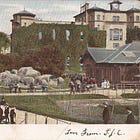Margin Notes: Don't Poke the Rhino
An inside look at my approach and processes, and some of the challenges faced
Release date: September 9, 2025
Hi, and welcome to the Margin Notes on Don’t Poke the Rhino. If you haven’t read it yet, click the link below to get started!
Today, I’ll be sharing a little about where I found this fantastic lost & found story, my over all approach to it, and a bit of content that didn’t make it into the finished story.
So let’s, see what we find!
Way more than just lions, tigers and bears, oh my!
I’m going to be honest. When I came across this scrollable, shocking, nearly unbelievable headline, I absolutely thought the story accompanying it must true. I mean, what kind of editor or publisher would dedicate an entire front page of their publication to a hoax?
And who would come up with such a horrible concept? And why?
If you haven’t’ read the original newspaper article, btw I do not blame you.
It is over 10,000 words. For reference, reading 10,000 words takes the average reader about 40 minutes, and a speech of 10,000 words would take more than an hour. Printed out as a PDF, the story is 22 pages.
It was written in the literary style of 1874. If you’re curious what that means, here’s a fairly typical sentence from the piece:
“Few of the millions who have visited Central Park, and who, passing in through the entrance at East Sixty-fourth street, have stopped to examine the collection of birds and animals grouped around the old Arsenal building, could by any possibility have foreseen the source of such terrible danger to a whole city in the caged beasts around him, as the trivial incident of yesterday afternoon developed.” If you’re counting, that’s 56 words in one sentence! I don’t know about you, but I’m feeling a wee better about my own rambling tendencies.
There are a lot of inside jokes, cultural references and NYC-in-1874-specific details that probably made the story a lot more believable, not to mention enjoyable, when it was written. The writer knew his audience, so when he mentioned a local celebrity — someone like Lester Wallack or Whitelaw Reid — he didn’t bother to say that the first was a famous actor and the second the editor of a competing paper.
But I digress. If you haven’t read the original piece but would like to, grab a beverage or two — I suggest something caffeinated, get comfy and click the link below. I’ll wait.
Welcome back!
In his 1893 Harper’s Weekly piece, Thomas Bernard (T. B.) Connery — the managing editor of the New York Herald and the guy behind the “wild-beast hoax”, noted that the first draft of the piece gave the punch line away too soon. The same cannot be said about the piece which was eventually published, which is probably why so many New Yorkers panicked, and why a reader like me, some 132-years later, kept reading, gruesomely, astonishingly mesmerized.
49 killed, of which only 27 had been identified because, you know, the beasts
200 resident mutilated, trampled and injured, 60 in serious condition
12 of the wild, carnivorous beasts still at large in the city
Then there was the police and military response, the detailed but succinct official-sounding announcement from the mayor — all weirdly believable.
In fact, even the inciting event — the eye poke, the mad rhino, the poorly-constructed cage, struck me as possible.
When I was little there was a small, private “zoo” in a nearby town, and we would stop there for a picnic on our way through from time to time. That was back in the day when Big Animals were imprisoned in Tiny Cages, and the Bear was huge. If I had a nickel for every time Dad warned me to “back away from the cage” because the bear could “rip that apart like tooth picks”, I’d have a lot of nickels.
So, yes, did I believe a rhino could destroy his own cage and then go on a cage-killing rampage and free all his buddies? Absolutely.
Plus, it was a sensational, fast-paced and meticulously detailed story, right?
My first inkling that something was amiss was in the middle of the third column. Did you catch it?
In a few moments more he had broken down the pens of the wild swine, the manatee, the American tapir, the two-toed sloth and the pair of kangaroos.
A manatee?
With my BS meter clicking in my ear, I kept reading. And then there was another one:
The giraffe made but a feeble struggle and death speedily ended his sufferings. Then it was the awful spectacle was seen of the anaconda seeking to swallow the body of his victim.
And another, and then another.
By the time I got to the Big Reveal, I was pretty sure I was reading fiction. And, I may not have been outraged, but I definitely wasn’t thrilled about the wasted investment.
(That said, reading it a second time and knowing it was a hoax, there were some really clever bits, like making the venerated NY politician Richard Shell the only person convinced the whole thing was a hoax, right up until he finds himself in the middle of things with “some animal of the tiger species” and then witnesses a battle Royale between a bear and a buffalo. How do you convince skeptical people something is real? Force another skeptic to believe it first!)
A little about the research and a tip
After reading the original story maybe three times through, I couldn’t help but think there must have been some push-back from the local NYC press, not to mention government and law enforcement officials, so I headed over to the NY newspaper archives to do some digging.
While there was plenty to be found from the Herald’s competitors — mostly scathing commentaries on yellow journalism and betrayal of public trust, there was, surprisingly, little I could find from authorities. A few mentions here and there, but not what I was expecting or looking for i.e. reports of mass hysteria and chaos on the streets, accidental shootings as people saw wild beasts behind every bush, an uptick in smelling salts to deal with all the fainting women.
And, since this was a fabricated story, there really wasn’t much else to research. There were no corroborating reports, no additional information out there about an event that never happened. No eye witness accounts.
Here’s a process tip on how I use newspaper archives when I have a dated story like I did for this story:
I start with the week of the event, and then slowly expand my date range to the month, then to a month on either side, then three months after, then a year after, then two, then five, then 10, and then I keep going in five-year increments. Of course, research is never a straight line, and if I find something cool, I’ll chase it down, then go back to the plan, as needed.
In this case, going slow and wide made the story, as I found a short reference to the 1893 Harper’s Weekly piece, which I eventually tracked down at both the Internet Archives and HathiTrust. They’re both high on my list for finding great content, btw, as is Google Books.
Finding T. B.’s “story-behind-the-story” was the reason I stuck with this piece. Without it, the Awful Calamity was either a mean spirited joke or a really stupid joke gone wrong, and neither of them was a story I was interested in telling.
If you’re interested in reading the complete Harper’s Weekly piece, here’s a link. It’s much shorter, and as, always HP’s artwork is fabulous!
How to swallow a 15K-word story
You might think the biggest challenge in sharing this lost & found story was the sheer volume of material. Again more than 10,000 words in the original 1874 story — the length of a solid short story or novella. And then nearly another 5,000 in the 1893 story.
And that was a challenge, but not the biggest.
Keep reading with a 7-day free trial
Subscribe to The Lost & Found Story Box to keep reading this post and get 7 days of free access to the full post archives.





